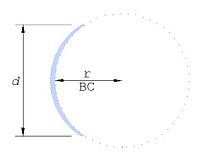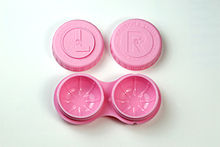Contact lens
Contact lenses are ocular prosthetic devices used by over 150 million people worldwide,[1] and they can be worn to correct vision or for cosmetic or therapeutic reasons.[10][11] John Herschel, in a footnote to the 1845 edition of the Encyclopedia Metropolitana, posed two ideas for the visual correction: the first "a spherical capsule of glass filled with animal jelly",[12] the second "a mould of the cornea" that could be impressed on "some sort of transparent medium".[13] Though Herschel reportedly never tested these ideas, they were later advanced by independent inventors, including Hungarian physician Joseph Dallos, who perfected a method of making molds from living eyes.[17] Approximately 18–21 mm (0.71–0.83 in) in diameter, the heavy blown-glass shells rested on the less sensitive rim of tissue surrounding the cornea and floated on a dextrose solution.He experimented with fitting the lenses initially on rabbits, then on himself, and lastly on a small group of volunteers, publishing his work, "Contactbrille", in the March 1888 edition of Archiv für Augenheilkunde.In 1936, optometrist William Feinbloom introduced a hybrid lens composed of glass and plastic,[21] and in 1937 it was reported that some 3,000 Americans were already wearing contact lenses.[citation needed] One of the major disadvantages of PMMA lenses is that they allow no oxygen to get through to the conjunctiva and cornea, causing a number of adverse and potentially serious clinical effects.The principal breakthrough in soft lenses was made by Czech chemists Otto Wichterle and Drahoslav Lím, who published their work "Hydrophilic gels for biological use" in the journal Nature in 1959.[35] The Czech scientists' work led to the launch of the first hydrogel contact lenses in some countries in the 1960s and the first approval of the Soflens material by the US Food and Drug Administration (FDA) in 1971.Polymers from which soft lenses are manufactured improved over the next 25 years, primarily in terms of increasing oxygen permeability, by varying the ingredients.These new materials encapsulated the benefits of silicone which has extremely high oxygen permeability—with the comfort and clinical performance of the conventional hydrogels that had been used for the previous 30 years.Its patent claims that the material uses two siloxy macromers of diverse sizes that, when used in combination, produce very high oxygen permeability for a given water content.Monovision[42] is the use of single-vision lenses (one focal point per lens) to focus an eye (typically the dominant one) for distance vision and the other for near work.Like any contact lens, cosmetic lenses carry risks of mild to serious complications, including ocular redness, irritation and infection.[54] Due to their medical nature, colored contact lenses, similar to regular ones, are illegal to purchase in the United States without a valid prescription.A new trend in Japan, South Korea and China is the circle contact lens, which extend the appearance of the iris onto the sclera by having a dark tinted area all around.Because of drastic differences in oxygen permeability, replacement schedule, and other design characteristics, it is very important to follow the instructions of the eye care professional prescribing the lenses.Although the materials are alike, differences in the manufacturing processes determine if the resulting lens will be a "daily disposable" or one recommended for two- or four-week replacement.Towels, unless freshly laundered on high temperature wash, are frequently contaminated with large quantities of bacteria and, as such, should be avoided when handling lenses.A 'gritty' or rough appearance to the lens surface may indicate that a considerable quantity of proteins, lipids and debris has built up on it and that additional cleaning is required; this is often accompanied and felt by unusually high irritation upon insertion.[96] Factors leading to eye damage varies,[97] and improper use of a contact lens may affect the eyelid, the conjunctiva, and, most of all, the whole structure of the cornea.Decreased corneal sensitivity after extended contact lens wear may cause a patient to miss some of the earliest symptoms of such complications.[101] The way contact lenses interact with the natural tear layer is a major factor in determining lens comfort and visual clarity."[102] Long-term wear of rigid contacts is associated with decreased corneal keratocyte density[103] and increased number of epithelial Langerhans cells.[108][109] Microbial keratitis is a serious focal point of current research due to its potentially devastating effect on the eye, including severe vision loss.[114] Besides bacterial adhesion and cleaning, micro and nano pollutants (biological and manmade) is an area of contact lens research that is growing.Small physical pollutants ranging from nanoplastics to fungi spores to plant pollen adhere to contact lens surfaces in high concentrations.Compliance is a major issue[116] pertaining to the use of contact lenses because patient noncompliance often leads to contamination of the lens, storage case, or both.The introduction of multipurpose solutions and daily disposable lenses have helped to alleviate some of the problems observed from inadequate cleaning but new methods of combating microbial contamination are currently being developed.One application is a lens that releases anesthesia to the eye for post-surgery pain relief, especially after PRK (photorefractive keratectomy) in which the healing process takes several days.














Contacts (Apple)ContactMonovision (album)disposablelensescorrect visioncosmeticglassesperipheral visionkeratoconusaniseikoniaLeonardo'sLeonardo da VincicornealaccommodationDescartesblinkingThomas Youngrefractive powerJohn HerschelEncyclopedia Metropolitanaanimal jellyAdolf Gaston Eugen FickLouis J. Girardscleral contact lensafocalblown-glassdextroseAugust Müllermyopiapolymethyl methacrylateWilliam FeinbloomHeinrich WöhlkLyndon Baines JohnsonRLI Corp.conjunctivaoxygen-permeableNorman Gaylordpolymersrigid gas permeableOtto WichterleDrahoslav LímNational Patent Development CorporationBausch & LombhydrogelFood and Drug AdministrationCiba Visionoxygen permeabilitygalyfilcon AAcuvuesenofilcon Awetting agentComfilcon AEnfilcon ACorrectiverefractive errorhypermetropiaastigmatismpresbyopiabifocalsprogressive lensesfocal pointsstrabismuscolor deficienciescolor visionachromatopsiapeople with dyslexiaMagnificationcircle contact lensmissingScleral lensdry eye syndromemicrophthalmiacorneal ectasiaStevens–Johnson syndromeSjögren's syndromeaniridiaaberrations of the eyepellucid degenerationbullous keratopathydry eyescorneal abrasionserosionkeratitisdescemetoceleMooren's ulcerscleraoxygencorneaectasiasList of soft contact lens materialssilicone hydrogelsiliconecorneal ulcercorneal neovascularizationallergensallergiesDiamond turningdiamondBase curve radiusDiameterOptical powerdioptersophthalmologistsoptometristsopticianseye examinationrefractionKeratometryFairness to Contact Lens Consumers Actwash handsmoisturizerssalinitycanthuscapillary actionplungersAcanthamoebaeHydrogen peroxide contact solutionsAmerican Academy of OphthalmologybiofilmsSaline solutionpreservativesbenzalkonium chloridebenzyl alcoholshelf livesthiomersal